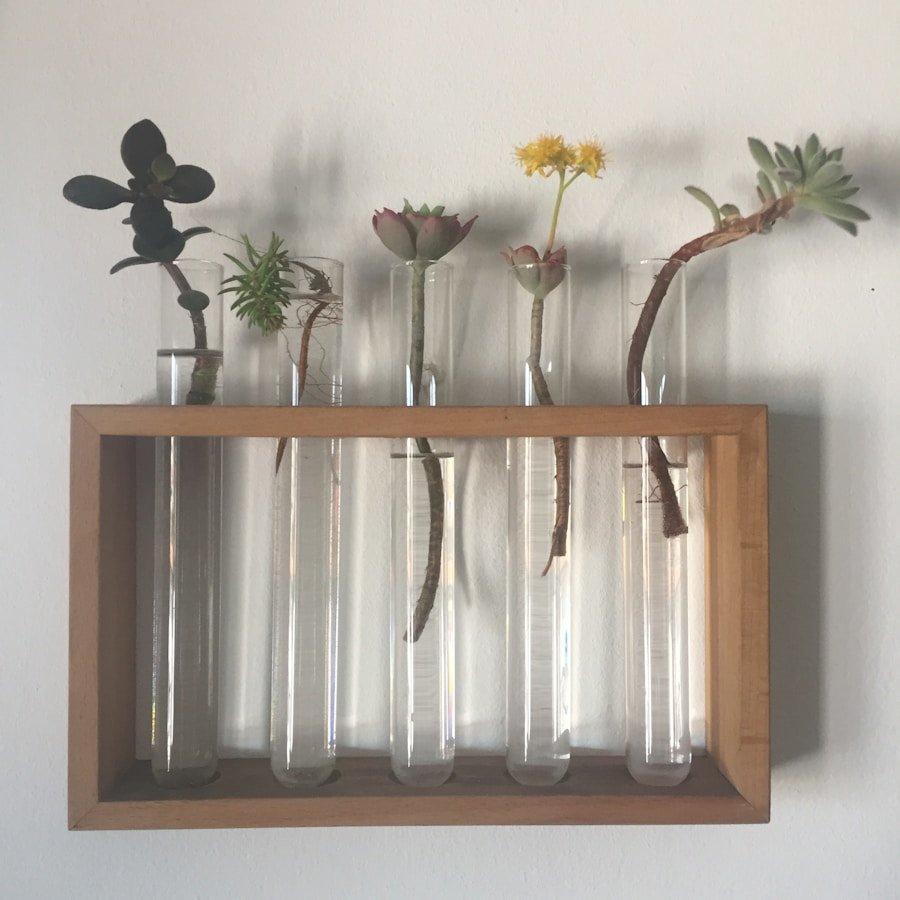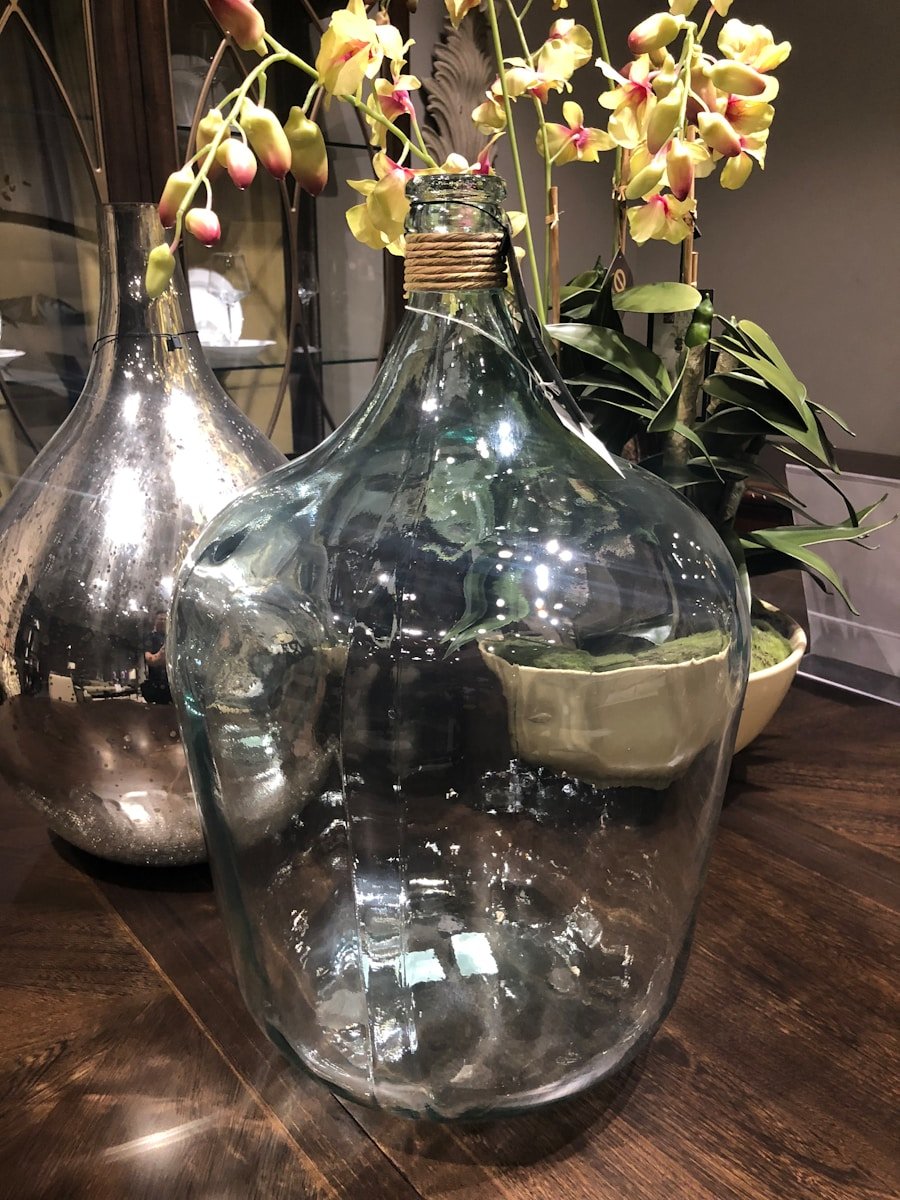Glass bottle planters have gained popularity in recent years, not only for their aesthetic appeal but also for their numerous practical benefits. One of the most significant advantages of using glass bottles as planters is their ability to create a unique and visually striking display. The transparency of glass allows for a clear view of the soil and roots, which can be particularly captivating when combined with colorful plants or decorative stones.
This visibility can enhance the overall ambiance of a space, making it feel more vibrant and alive. Additionally, glass bottles come in various shapes and sizes, allowing for endless creativity in design and arrangement. Another notable benefit of glass bottle planters is their durability.
Unlike traditional ceramic or plastic pots, glass is less prone to cracking or fading over time. This longevity makes glass bottles an excellent choice for both indoor and outdoor gardening. Furthermore, glass is non-porous, which means it does not absorb moisture or nutrients, allowing for better control over the growing environment.
This characteristic can be particularly advantageous for plants that require specific humidity levels or for those who are new to gardening and may struggle with overwatering or underwatering.
Key Takeaways
- Glass bottle planters provide a stylish and eco-friendly way to repurpose bottles and create a unique garden display.
- When choosing the right size and shape for your glass bottle planter, consider the space available and the type of plants you want to grow.
- Selecting the ideal glass thickness is important for the durability and stability of the planter, especially for outdoor use.
- Proper drainage and watering needs should be considered to ensure the health and growth of the plants in the glass bottle planter.
- Matching the glass bottle planter with the right plant is essential for creating a harmonious and visually appealing display.
Choosing the Right Size and Shape
When selecting a glass bottle planter, size and shape are crucial factors that can significantly impact plant health and growth. The size of the bottle should correspond to the type of plant being grown; larger plants with extensive root systems will require more space than smaller varieties. For instance, a tall, narrow bottle may be suitable for growing herbs like basil or mint, while a wider, shorter bottle could accommodate a succulent or a small flowering plant.
It is essential to consider the mature size of the plant to ensure that it has enough room to thrive without becoming root-bound. The shape of the glass bottle also plays a vital role in the overall aesthetic and functionality of the planter. Unique shapes can add character to your gardening setup, but they may also affect how water drains and how easily you can access the soil.
For example, a round bottle may be more challenging to water than a square one with a wider opening. Additionally, consider how the shape will fit into your intended display area. A collection of variously shaped bottles can create an eye-catching arrangement, while uniform shapes may lend a more cohesive look.
Selecting the Ideal Glass Thickness

The thickness of the glass used in bottle planters is another important consideration that can influence both durability and insulation properties. Thicker glass tends to be more robust and less likely to break under pressure or during temperature fluctuations. This is particularly relevant for outdoor planters that may be exposed to harsh weather conditions, such as freezing temperatures or intense sunlight.
Thicker glass can provide better insulation for the roots, helping to maintain a stable temperature and protect plants from extreme conditions. On the other hand, thinner glass bottles can be more lightweight and easier to handle, making them suitable for indoor use or for those who frequently rearrange their plants. However, it is essential to ensure that these bottles are still made from quality materials to prevent shattering or cracking.
When selecting glass thickness, consider the specific needs of your plants and the environment in which they will be placed. For instance, if you live in an area with significant temperature fluctuations, opting for thicker glass may be wise to provide better protection for your plants.
Considering Drainage and Watering Needs
| Plant Type | Watering Needs | Drainage Requirements |
|---|---|---|
| Succulents | Low | Well-draining soil |
| Ferns | High | Regular watering and good drainage |
| Roses | Medium | Good drainage to prevent root rot |
| Tomatoes | Regular | Well-draining soil and consistent watering |
Proper drainage is critical for the health of any plant, and glass bottle planters present unique challenges in this regard. Unlike traditional pots that often come with drainage holes, many glass bottles do not have this feature by default. Therefore, it is essential to consider how you will manage excess water to prevent root rot and other moisture-related issues.
One common solution is to layer the bottom of the bottle with small stones or gravel before adding soil. This creates a natural drainage layer that allows excess water to escape while still providing adequate support for the plant’s roots. Watering needs also vary significantly among different plant species, so understanding these requirements is crucial when using glass bottle planters.
Some plants prefer consistently moist soil, while others thrive in drier conditions. When using a glass bottle planter, it is essential to monitor moisture levels closely since the transparent nature of glass can make it challenging to gauge soil dampness visually. Using a moisture meter can help ensure that you are providing the right amount of water for your specific plants.
Additionally, consider using self-watering systems or incorporating wicking methods to maintain consistent moisture levels without overwatering.
Matching the Glass Bottle Planter with the Right Plant
Choosing the right plant for your glass bottle planter is essential for creating a thriving indoor garden. Not all plants are suited for this type of environment; therefore, it is crucial to match your plant selection with the specific conditions provided by the glass bottle. For example, succulents and cacti are excellent choices due to their low water requirements and ability to thrive in well-draining soil.
Their unique shapes and colors can also create stunning visual displays when showcased in transparent containers. Alternatively, if you prefer leafy greens or herbs, consider using smaller varieties that do not require extensive root systems. Herbs like thyme, chives, or small varieties of lettuce can flourish in glass bottle planters while adding both beauty and functionality to your space.
It is also worth noting that some plants may benefit from being grown in pairs or groups within a single bottle, creating a mini ecosystem that can enhance humidity levels and promote healthy growth.
Decorating and Personalizing Your Glass Bottle Planter

One of the most enjoyable aspects of using glass bottle planters is the opportunity for personalization and decoration. There are countless ways to enhance the visual appeal of your planters beyond simply filling them with soil and plants. For instance, you can paint or etch designs onto the surface of the glass to create a unique look that reflects your personal style.
Using non-toxic paint ensures that your plants remain safe while allowing you to express your creativity. In addition to painting, consider incorporating decorative elements such as colored stones, pebbles, or sand at the bottom of the planter for added texture and visual interest. These materials can also serve practical purposes by improving drainage and aeration within the soil.
Furthermore, you can use twine or ribbon to wrap around the neck of the bottle for an added rustic touch or attach small tags with plant names or care instructions for easy identification.
Maintenance and Care Tips for Glass Bottle Planters
Maintaining glass bottle planters requires attention to detail but can be quite rewarding when done correctly. Regular monitoring of moisture levels is essential; since glass does not absorb water like other materials, it is easy to overlook when plants need watering. Establishing a routine check-in schedule can help ensure that your plants receive adequate hydration without becoming waterlogged.
Cleaning is another important aspect of care for glass bottle planters. Over time, algae or mineral deposits may accumulate on the interior surfaces of the glass, obstructing visibility and potentially harming plant health. To clean your planters effectively, use a mixture of vinegar and water or a gentle soap solution with a soft brush to scrub away any buildup without scratching the glass surface.
Rinsing thoroughly afterward will help remove any residue that could affect your plants.
Eco-Friendly and Sustainable Options for Glass Bottle Planters
In an era where sustainability is increasingly important, using glass bottles as planters aligns well with eco-friendly practices. Repurposing old bottles not only reduces waste but also gives new life to materials that might otherwise end up in landfills. This practice encourages creativity while promoting environmental consciousness among gardeners and plant enthusiasts alike.
Moreover, many companies now offer eco-friendly options specifically designed for gardening purposes. These products may include recycled glass bottles or sustainably sourced materials that minimize environmental impact during production. By choosing these options, gardeners can contribute positively to sustainability efforts while enjoying the beauty and functionality of glass bottle planters in their homes or gardens.
If you are looking to spruce up your home with some new decor, you may also be interested in finding the perfect shower caddy for your small bathroom. Check out this article on the 5 best shower caddies for small bathrooms to help you make the right choice. Just like choosing a glass bottle planter, selecting the right shower caddy can make a big difference in the overall look and feel of your space.
FAQs
What are the factors to consider when choosing a glass bottle planter for my home?
When choosing a glass bottle planter for your home, consider factors such as size, shape, style, and the type of plants you want to grow.
What size of glass bottle planter should I choose for my home?
The size of the glass bottle planter you choose will depend on the space available in your home and the size of the plants you want to grow. Consider the height and width of the planter to ensure it fits in your desired location.
What types of plants are suitable for glass bottle planters?
Glass bottle planters are suitable for a variety of plants, including succulents, air plants, herbs, and small flowers. Consider the amount of sunlight and water the plants require when choosing the type of plant for your glass bottle planter.
How do I choose a style of glass bottle planter that complements my home decor?
When choosing a style of glass bottle planter, consider the existing decor in your home. Look for a planter that complements the colors and style of your home, whether it’s modern, rustic, or traditional.
Where can I purchase a glass bottle planter for my home?
Glass bottle planters can be purchased at home and garden stores, online retailers, and specialty plant shops. Consider shopping around to find the best selection and price for your desired glass bottle planter.

